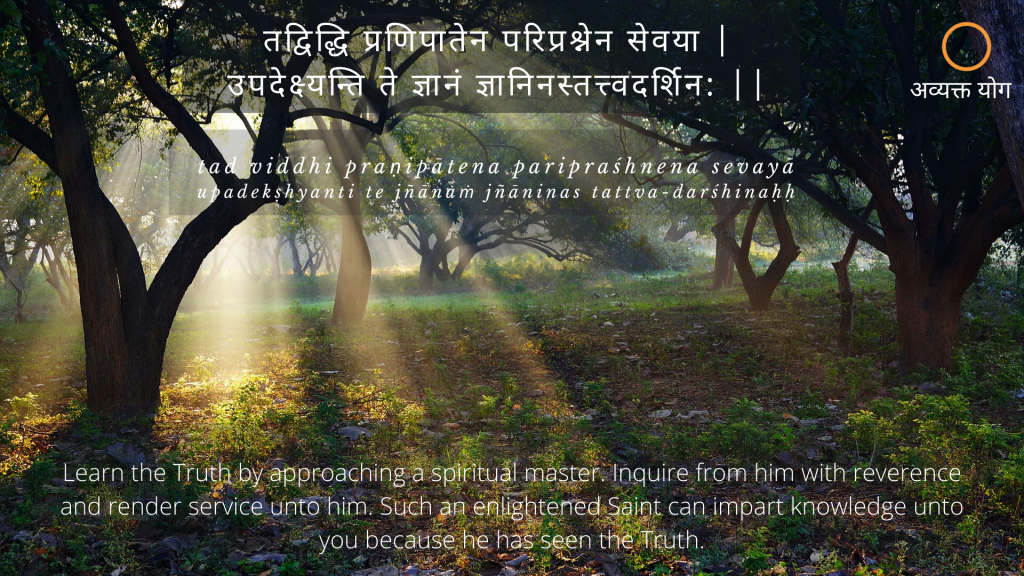तद्विद्धि प्रणिपातेन परिप्रश्नेन सेवया |
उपदेक्ष्यन्ति ते ज्ञानं ज्ञानिनस्तत्त्वदर्शिन: ||
tad viddhi praṇipātena paripraśhnena sevayā
upadekṣhyanti te jñānaṁ jñāninas tattva-darśhinaḥ
Srimad Bhagavad Gīta 4.34
Learn the Truth by approaching a spiritual master. Inquire from him with reverence and render service unto him. Such an enlightened Saint can impart knowledge unto you because he has seen the Truth.

In my quest to take up a śloka a day, I inadvertently end up at the Bhagavad Gīta. I cannot help it. The wealth of jñana in this scripture cannot be possibly explored in one lifetime…
This śloka speaks about gaining true knowledge, from a Guru. Not the knowledge that describes how outer things work – there are universities for that, and that superficial knowledge is not tat. Knowledge about the inner self, the ultimate truth is for seekers, for sādhakās. tat is what you take with you when you leave the world, the rest of the engineering and medical degrees stay back.
This śloka can also be meditated upon, when seeking any knowledge that brings one closer to one’s own nature.
Classical dance, yoga, martial arts, classical music…guru-shishya parampara was the backbone of learning in ancient India. These teachings are as relevant in today’s world, as they were thousands of years ago. To learn any discipline, the seeker has to have some basic qualities.
How do you acquire true knowledge from a Guru? Through –
Praṇipātena – Prostration – Not just falling at the feet of the Guru – that is a symbol of surrender. You have to surrender to your Guru – when you prostrate, your head and heart lie at their feet. This signifies devotion – a higher form of love. To surrender, one has to be sure of the Guru. There is a process of spiritual enquiry described in the Kaṭha Upaniṣad. Take your time, make your inquiry, but once you are sure, don’t doubt.
I have had the fortune of learning martial arts under a true Guru, and I have also attempted to teach martial arts (Kyokushin Karate) as a Guru. A lot of students come with preconceived notions, mostly gathered from movies, and expect the Guru to give them instant results. No, first you have to empty your cup. The famous and oft-quoted Zen story of the professor who went to visit Nan-in, is a derivative of what Śri Krśna says later in the Gīta –
सर्वधर्मान्परित्यज्य मामेकं शरणं व्रज |
– sarva-dharmān parityajya mām ekaṁ śharaṇaṁ vraja – abandon all other thoughts and notions, and surrender to me (the Guru). Only then can you take in fresh knowledge.
Paripraśhnena – by spiritual enquiry. You have to seek knowledge, not blindly accept it.
Questioning raises your capabilities, since you walk on the path of your own conviction, not blind faith.
But the method of questioning should be humble, and towards satisfying an enquiry, not trying to test the Guru. A lot of students question with the aim of finding a fault – such enquiry does not lead to growth, and also shows that the student failed to surrender to the Guru. No good learning can come of this.
The first two lead to knowledge – but can also create a sense of ego – I KNOW MORE.
The third step of sevā is as important – it helps tone down the growing ego and brings you closer to humility.
Sevā of only the Guru is not essential – a learned Guru does not need material things to make him complete. But you can contribute to the cause that the Guru has devoted his life to. And spread the message.
You can also use this practice to align your mind and attitude when learning anything new. The Guru in this case may not be dispensing the ultimate truth, but if you have selected him through proper inquiry, he has something that you wish to learn. Empty your pre-conceived notions, so that you can imbibe what he has to offer. Ask relevant questions, so that you can clarify your doubts and not work with assumptions.
And give back, in your own small way, to show thankfulness and gratitude. Your learning will be complete 🙂
